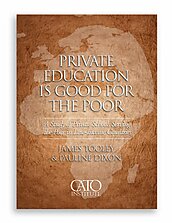Many observers believe that the private sector has very little to offer in terms of reaching the United Nations Millennium Development Goal of “education for all” by 2015. Private education is often assumed to be concerned only with serving the elite or middle classes, not the poor. And unregistered or unrecognized private schools are thought to be of the lowest quality and hence demanding of detailed regulation, or even closure, by governmental authorities.
Our findings from a two-year in-depth study in India, Ghana, Nigeria, and Kenya suggest that these conclusions are unwarranted. Private schools, we argue, can play—indeed, already are playing—an important, if unsung, role in reaching the poor and satisfying their educational needs.
The first component of our research consisted of a systematic census and survey of all primary and secondary schools, government and private, in selected low-income areas. The second component examined a stratified random sample of between 2,000 and 4,000 children from each of those areas. Tests in mathematics, English, and (in Africa) one other subject were administered. Children and teachers were also tested for their IQ, and questionnaires were administered to students, parents, teachers, and school managers or headteachers.
In each area, we found the majority of schoolchildren attending private schools. In the areas officially designated as “slums” of three zones of Hyderabad’s Old City, we found 918 schools, of which only 35 percent were government schools, fewer than the 37 percent of unrecognized private schools. In total, 65 percent of schoolchildren in those low-income areas attended private unaided school. In the Ga District of Ghana (the lowincome suburban and rural area surrounding the capital city of Accra) we investigated 779 schools in the same way, finding that only 25 percent were government schools and that 64 percent of schoolchildren attended private school.
In the “poor” areas of three local government districts (one rural, two urban) of Lagos State, Nigeria, we found 540 schools, of which 34 percent were government, and the largest proportion, 43 percent, were private unregistered. An estimated 75 percent of schoolchildren were enrolled in private schools.
We also conducted research in the small shanty town of Makoko, in Mainland, Lagos State, and in the slum of Kibera, Nairobi, Kenya (reportedly the largest slum in sub-Saharan Africa). In both cases, the large majority of poor children attended private, not public, school. Moreover, in Kenya we were able to observe the impact of free primary education on enrollment. Despite the fact that huge increases in enrollment have been noted in government schools by commentators, our research suggests that, at best, children appear to have transferred from private to government schools. Given the advantages of private schools and problems found in government schools, that may not be to their advantage.
In each location, the private schools are run largely by proprietors, with very few receiving outside philanthropic support and none receiving state funding. Roughly equal numbers of boys and girls attend private unaided schools, which have better pupil-teacher ratios, higher teacher commitment, and sometimes better facilities than government schools. A significant number of places in private unaided schools are provided free or at reduced rates to serve the poorest of the poor.
The raw scores from our student achievement tests show considerably higher achievement in the private than in government schools. In Hyderabad, for instance, mean scores in mathematics were about 22 percentage points and 23 percentage points higher in private unrecognized and recognized schools, respectively, than in government schools. The advantage was even more pronounced for English. In all cases, this achievement advantage was obtained at between half and a quarter of the teacher salary costs.
Our research indicates that a great success story is taking place, usually beneath the government’s radar. The mushrooming private schools, if noticed at all by the authorities and development experts, are assumed to be educationally inadequate. Our research shows that this assumption is false. Moreover, because so many children are in unrecognized private schools that do not appear in government statistics, achieving universal basic education — the United Nations Millennium Development Goal of “education for all” — may be much easier to reach than is currently believed. In Lagos State, for instance, including enrollment in private unregistered schools would reduce the percentage of out-of-school children from 50 to 26 percent.
Certainly, the private schools for lowincome families could be improved even further by creating revolving loan programs to help infrastructural investment or, following the private schools’ own example, creating targeted voucher programs to enable the poorest of the poor to attend private schools. But above all, the existence and the contribution of private schools to “education for all” is a cause for celebration.
About the Authors
James Tooley is professor of education policy at the University of Newcastle and director of the E.G. West Centre. Pauline Dixon is international research coordinator of the E. G. West Centre in the School of Education at the University of Newcastle.

This work is licensed under a Creative Commons Attribution-NonCommercial-ShareAlike 4.0 International License.
